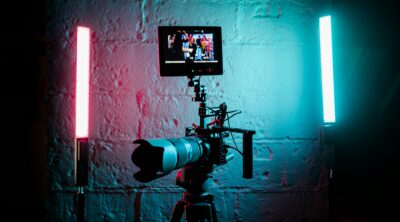< Back to all posts
How Colors Can Influence Your Video Audience
When you create a video, there’s much more at play than you might realize. The messaging, tone, and backdrop will evoke emotions from your audience, but artistic choices such as color will also play a major factor. In fact, color is one of the most powerful psychological tools when it comes to marketing and branding.
Here’s everything you need to know about how color affects your audience, and how you can take advantage of it:
The Effects of Each Color
Before discussing how to use color in videos, it’s important to know exactly what each color represents. Here’s how each color psychologically affects your audience:
- Red – a physical color. It depicts power, strength, and courage. It raises the pulse rate and grabs attention immediately. If it is overused, it can be perceived as threatening or aggressive.
- Blue – a color of intellect. It is a soothing color that depicts intelligence. Blue is extremely soothing and creates a feeling of serenity, calm, and coolness. It is a favorite color for both men and women. In heavy doses, it may become unfriendly or unemotional.
- Yellow – an extremely stimulating color, yellow evokes emotion. It is extremely optimistic and creates a feeling of creativity and confidence. It can, however, creative negative emotions such as fear or depression.
- Green – the color of balance. Green is a natural, peaceful color. It represents balance and harmony. As the color of nature, it offers reassurance. On the negative side, green can become boring when it’s used too heavy-handedly.
- Purple – the most spiritual color. It shows truth, spiritual awareness, and quality. Typically, purple is associated with luxury and royalty. If you use purple too often, it may cause concern among viewers as it can communicate poor quality.
- Orange – by combining yellow and red, orange can be seen as a combination of physicality and emotion. It’s a fun, sensual color and focuses us on basic needs such as warmth and food. Too much orange will take fun to the extreme and create a feeling of ignorance.
- Pink – as a subtle red, pink is physical yet soothing. It’s an extremely powerful color psychologically, strongly invoking feminine principles. Pink is extremely soothing and nurturing, and represents love. Too much pink may become emasculating and turn off your male audience.
- Gray – gray is the most neutral color, and using it too often will inspire boredom or show you lack inspiration or confidence. Grey should not be highlighted and is best used sparingly to break up other colors.
- White – reflecting all other colors, white is extremely bright and sometimes difficult to stare at. It creates a mental barrier and depicts purity, efficiency, and clarity. Be careful where you use white, as when used next to other warm colors, it can make them feel overly bright.
- Black – the complete opposite of white, black absorbs all other colors. It grabs attention, sometimes negatively. Black can create the perception of oppression, heaviness, and the unknown. Used lightly, though, black can create positive feelings of sophistication, security, and excellence.
- Brown – an earthy color, brown contains mostly yellow and red, with just a hint of black. It’s a serious, reliable color that reminds people of nature and feels supportive. Too much brown, however, might make your videos overly serious and create a heavy tone.

Deciding Which Colors to Highlight
The decision to highlight one or more particular colors depends primarily on the message you’re trying to tell. A fun, more lighthearted video should be accompanied by yellow or orange, while a more serious video can highlight brown or even blue to create a sense of calm. Whenever possible, try tying the color choices you make in your video content to the colors used in the rest of your branding.
It’s also important to keep your audience’s preferences in mind. You should know whether your audience is primarily male, female, or a mix of the two. Men and women have vastly different color preferences. For example, 57% of men claim blue is their favorite color, while only 35% of women claim blue is their favorite color. If you plan on using colors with a strong gender connotation, such as purple or green, you need to know exactly who your audience is and why you’re making those choices.
Ways to Use Colors
Once you decide to highlight a particular color in your video, you need to figure out exactly how you’re going to do it. If you’re shooting a how-to video, an interview, or anything else that involves one or two people in a single setting it’s easy to do so – use a background. You can use a paper background with a solid color. Another option would be to shoot in your actual office to give an authentic feel or out in the wood for an earthy, gritty tone.
You should also choose the clothes that your actors wear very carefully. The audience will generalize about each character based on what they’re wearing, and that will bleed out into how they feel about the video overall. Unless you specifically want to call attention to a particular person, it’s a good idea to use colors blend in well with the rest of the video’s background and imagery.
Using color can be extremely tricky. If the usage is too subtle, the meaning will be lost. If you use it too strongly, it can take a different meaning or overpower the rest of your message. For best results, you’ll need an experienced crew that knows how to lay each shot out perfectly. To get started finding your next crew, all you need to do is click here for a free quote.







This is a great article. I’ve been telling people for decades how color can captivate an audience, even if that audience is one person. I used to be in the sign business and used those principles all the time. Most companies already know this and use it daily in advertisements, commercials, or even packaging.
As far as this article, it’s interesting to see how each color can make a person feel.